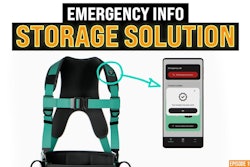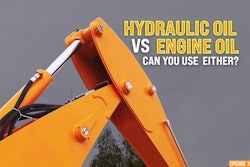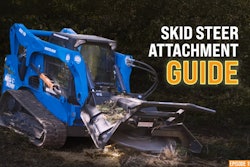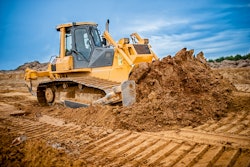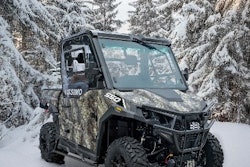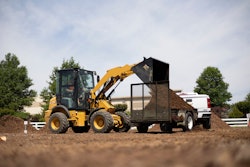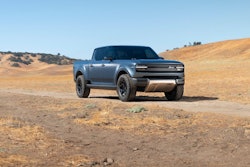When it’s time for mass excavation, Dig Robotics has developed aftermarket technology that helps operators move more dirt in less time with less fuel, according to its cofounder.
Noam Rotem, Dig Robotics’ cofounder and chief excavation officer, comes on The Dirt to explain how the “operator guidance” system works and why it’s different than machine control.
The system’s hardware is bolted on to equipment, such as excavators, dozers and wheel loaders, and an in-cab touchscreen shows operators the optimal digging operation. Rotem says it is designed to get material out as quickly and efficiently as possible with less wear and tear on the machine and less fuel consumption.
Whereas, machine control is focused on grade accuracy, Dig Robotics focuses on the mass earthmoving before it’s time to focus on grade. Its main goal is full buckets with each pass.
So to see if Dig Robotics could help your excavation operations, check out the latest episode of The Dirt.
Equipment World serves up weekly videos on the latest in construction equipment, work trucks and pickup trucks – everything contractors need to get their work done. Subscribe and visit us at equipmentworld.com!
In This Episode:
- 00:00 – Increase Operator Efficiency With Dig Robotics
- 00:33 – What is Dig Robotics?
- 01:35 – Is This Machine Control?
- 04:59 – Will Experienced Operators Benefit From Dig Robotics?
- 09:15 – Installation & Price
- 12:35 – Final Thoughts
00:00:00:09 - 00:00:24:00
Bryan Furnace
Today we're here to talk about technology and machines. We've traditionally talked about technology from a machine control standpoint, but what if there was something out there that was focused more on helping us become more efficient as operators? And that's exactly what Dig Robotics is designed for.
Here to talk with us is Noam Rotem from Dig Robotics.
00:00:33:04 - 00:00:39:15
Bryan Furnace
For beginners, for people who are totally unfamiliar. Can you give us an overview of your system and what it's doing in the field?
00:00:39:20 - 00:01:19:08
Noam Rotem
Sure, absolutely. Dig Robotics is an operator guidance system for all types of excavation machinery. So think excavators, bulldozers, wheel loaders, backhoes, even machines as small as compact loaders. Our system helps operators achieve continuously full buckets while reducing cycle time, fuel consumption and wear and tear on the machine, hydraulics and on the bucket and cartage. The system provides real time feedback regarding cut of the bucket, the angle and when to pull the bucket out to achieve that full bucket.
00:01:19:08 - 00:01:34:15
Noam Rotem
The minimum time and cost primarily in mass excavation projects. When you're looking to move as much material as you can in the shortest time possible, and it's a little course impossible. We are providing a 30% improvement in performance.
00:01:34:17 - 00:01:48:08
Bryan Furnace
So just to clear up any confusion, this is not machine control. It is separate and independent and really, truly accomplishes a different goal than machine control.
00:01:48:10 - 00:02:22:12
Noam Rotem
Absolutely. I think how we kind of tend to use the term machine control as a portal into great control, which is popular with a lot of machines, definitely over the last decade has become probably the most popular system system out there. Great control. The way we look at it, great control is really focused on accuracy. Giving the operator a warning as he's getting near the outer boundary of the excavation shape with Dig Robotics, powerful focus on all of the material within the boundaries.
00:02:22:14 - 00:02:56:22
Noam Rotem
In order to. We're helping the operator for each and every individual cycle from the very first time you're pushing your bucket into the material to get that material out as fast and as efficiently as possible, with little detail on the back end of the machine up until you reach those outer boundaries. And then if you have a great control system that can take over, we definitely see that for larger projects, the bulk of the work is happening within the boundaries where great control is not effective, but the robotic arm very effective.
00:02:57:00 - 00:03:09:15
Noam Rotem
Some excavation work, for example in mining and their open pit and quarry. There really is no application for great control because you don't have any boundaries and that's another place where the control up excels.
00:03:09:17 - 00:03:31:05
Bryan Furnace
So I do you make a of an interesting point that I think a lot of people don't really think about. Grade control is increasing the efficiency of the operator, but only for that last final pass or two. And we don't really do anything. We've largely not done anything with the other 98% of digging that we're doing the bulking phase.
00:03:31:05 - 00:03:37:15
Bryan Furnace
And here you're coming up with something that is specifically designed for the bulking phase of the dig.
00:03:37:17 - 00:04:08:23
Noam Rotem
Correct. So, you know, terms like productivity and efficiency get thrown around a lot. And I do believe that grade control is a terrific application, and it does have some derivative effect on your efficiency and productivity. Right. So when the operator is working within the boundaries, he does have some increased level of freedom to work a bit more aggressively because he knows he's going to be getting that warning when he's getting close to the boundary.
00:04:09:01 - 00:04:28:18
Noam Rotem
When it gets closer to the boundary, he's getting help to get that grade that you want. So that's fantastic. But just as you said, when you look at any kind of typical excavation, if it's anything as small as, you know, putting in a pool in your backyard, or if you're excavating five stories of underground parking in downtown Detroit, right.
00:04:28:20 - 00:04:51:21
Noam Rotem
The bulk of the work is happening within the boundaries where grade control is essentially not relevant and big. A Dig Robotics team focused on everything that happens within those boundaries, helping the operator for each individual cycle to ensure that he's getting the full bucket in the shortest cycle time possible, and with no diesel consumption and the wear and tear on the machine.
00:04:51:21 - 00:04:58:13
Noam Rotem
So it really takes care of the bulk of the work. Regardless that you have a great control system event to help you or not.
00:04:58:15 - 00:05:20:10
Bryan Furnace
So this is where I'm going to play the industry pessimist. That's my role, Noam. We're putting only our very experienced operators in these large excavators. And these guys have been digging for years and they know how to dig. There are most efficient and productive operators we have out there. Why am I going to go spend money on this system to tell me they're already efficient?
00:06:02:09 - 00:06:26:15
Noam Rotem
Sure, that's a fair question. So I'm going to say, first of all, that for more novice operators, we are providing real time feedback. So as the operator is moving the buckets through the cut, we're able to tell them how deep, how far, what angle and when should be pulling up. For more experienced operators, we can switch over from a real time feedback to kind of a trend feedback.
00:06:26:15 - 00:06:49:23
Noam Rotem
So my co-founder Ken Gray, who's an avid golfer, likes to give the golf pro analogy, right. So if you're starting out playing, you want that golf pro to stand right next to you. Maybe he's holding you your hand and helping you do the swing. But even if you're an experienced golfer, you might want a golf pro to stand a few feet out and just look at you in from time to time, tell you that you're not right.
00:06:49:23 - 00:07:00:00
Noam Rotem
You're not swinging your hips well, or maybe you're slicing your your hips right. I'm not a golfer. So that was my my best attempt at doing that. The golf analogy so similarly.
00:07:00:02 - 00:07:01:19
Bryan Furnace
Is a great analogy. Yeah.
00:07:01:19 - 00:07:43:17
Noam Rotem
Thank you. So a credit goes to our Ken who's our golfer. So I think honestly, we know that, on the bigger machines, you have typically more experienced operators and, they know their work. So we're not looking to overwhelm them with feedback to make it annoying. But we are able to give them insight as a trend or as a report to help them be more aware to issues that maybe they're not accustomed to considering, like maybe a trend to do a bit too deep just to ensure they're getting the full bucket, and they can provide the same level of productivity for their company without putting so much wear and tear on the machine or
on the bucket, or without consuming so much diesel. I think the depth for a lot of the operators who are working with companies who they have a true connection with, they want to be better. They want to bring a better result for the company. I think it's a win win. We are currently deploying our system, on two 100 metric ton machines.
00:08:05:13 - 00:08:33:07
Noam Rotem
These are and they have tremendous operators. They're the operators of these machines, have been working with them from the moment they were purchased about 25 years ago. So these guys know their work. With that being said, these are machines that are going through 50,000 gallons of diesel. Yeah. So if we can help them reduce 10 to 15% of the diesel that they're consuming and still keep up the same level of productivity, this is good for the business.
00:08:33:07 - 00:08:55:14
Noam Rotem
But at the end of the day, it's also a good thing for the operator when he can do a better job for his boss. That's the way I see it. We will be deploying later this year. Two systems in the U.S with company called dirt on 275 excavators. So it's true that smaller machines tend to have more novice operators who need the training.
00:08:55:16 - 00:09:14:05
Noam Rotem
However, the bigger machines having higher cost of operation and typically are working in more intense applications where improving by 10% or 15%. At the end of the day, cash wise has a bigger payoff, so we're seeing interest from both sides of the spectrum.
00:09:14:07 - 00:09:24:16
Bryan Furnace
Interesting. So my final question for you is this sounds like it's pretty involved. What does it take to do an installation? And it sounds like it would be spendy.
00:09:24:22 - 00:09:50:07
Noam Rotem
So it's a good question and I want to clarify. So our initial product which is we're still in development phase. Our initial product is a purely peripheral guidance system without intervening. We generally believe that there's a lot of work that can be done in-house and the operator rather than trying to replace them. With that being said, it's a bolt on aftermarket system, so basically, we're putting a 3D camera.
00:09:50:08 - 00:10:15:00
Noam Rotem
We're bolting it on to the roof of the cab. We're tapping into the diagnostic socket to read a fuel consumption hydraulic information, hydraulic pump, rpm and other information. And we're putting a touchscreen in the cab, kind of like a grade control screen. So we're going to have another basically, another screen in your cab. Sorry. Sorry for taking up some more real estate.
00:10:15:02 - 00:10:24:16
Noam Rotem
And this is a system that we are engineering. So an operator can bolt it on and calibrate it in less than two hours.
00:10:24:18 - 00:10:28:00
Bryan Furnace
Oh, so we don't even need to bring a specialized technician out.
00:10:28:00 - 00:10:49:21
Noam Rotem
That's the way we're designing it now. You know, potentially some customers might prefer having a technician come out the way we're going to be marketing the robotic system. We're talking to dealers. So if you're a binder machine or a service on your machine after dealer, your Cat or Volvo, your Komatsu, whomever is your dealer, we're looking to be working with dealers.
00:10:49:21 - 00:11:18:00
Noam Rotem
We're also looking to work with rental companies. So basically, if you're renting out the machine from a rental company without naming any kind of names, they can offer you to install on your machine and robotic system. So even if you're an experienced operator, you're obviously not experienced with that specific machine. So by getting a Dig Robotics kind of a upgrade on that machine, you're basically ensuring that you'll be getting maximum results from your machine from day one.
00:11:18:02 - 00:11:42:21
Noam Rotem
If you're taking it for a week, month and three months, I think, which is a interesting value proposition pricing wise. We're looking to have the system rented out somewhere around $500 a month, so you don't need to purchase the system and keep it, a a on your side continuously. So, so those dealers or those rental companies can basically offer you to rent it out.
00:11:42:23 - 00:12:06:20
Noam Rotem
You can do it per machine, or if you have a specific project that you want to increase your performance, or if you have an operator who you think can benefit from having Dig Robotics for a couple of months. We think that in that kind of a price range and with the value that we're generating, you will want to have a robotic system on all of your machines on basically the bulk of your project.
00:12:06:22 - 00:12:24:07
Noam Rotem
So we're very confident that the value that we're generating at that price range is significant. And customers, it's the price point where they can say, I'll take it for a month and see. And at the end of the month you're going to see that you're going to be moving more dirt in less time. And more detail, and that you're going to want to keep it on your machine.
00:12:24:09 - 00:12:33:14
Bryan Furnace
Excellent. This is interesting. This is a very different conversation than the normal tech conversations we have. So Noam, thank you. So much for the time. I really appreciate it.
00:12:33:16 - 00:12:35:06
Noam Rotem
Sure was great talking.
00:12:35:09 - 00:12:52:04
Bryan Furnace
Well, thank you again Dig Robotics coming on the show to talk about the future of the industry and how this technology will play a critical role not only in helping current operators, but future autonomous machines down the road. As always, I hope this helps you and your business. We'll catch you on the next episode of The Dirt.
